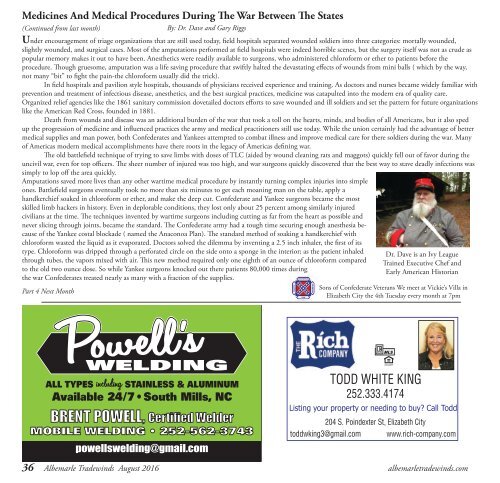Albemarle Tradewinds August 2016 Web Final
August 2016
August 2016
You also want an ePaper? Increase the reach of your titles
YUMPU automatically turns print PDFs into web optimized ePapers that Google loves.
Medicines And Medical Procedures During The War Between The States<br />
By: Dr. Dave and Gary Riggs<br />
(Continued from last month)<br />
Under encouragement of triage organizations that are still used today, field hospitals separated wounded soldiers into three categories: mortally wounded,<br />
slightly wounded, and surgical cases. Most of the amputations performed at field hospitals were indeed horrible scenes, but the surgery itself was not as crude as<br />
popular memory makes it out to have been. Anesthetics were readily available to surgeons, who administered chloroform or ether to patients before the<br />
procedure. Though gruesome, amputation was a life saving procedure that swiftly halted the devastating effects of wounds from mini balls ( which by the way,<br />
not many “bit” to fight the pain-the chloroform usually did the trick).<br />
In field hospitals and pavilion style hospitals, thousands of physicians received experience and training. As doctors and nurses became widely familiar with<br />
prevention and treatment of infectious disease, anesthetics, and the best surgical practices, medicine was catapulted into the modern era of quality care.<br />
Organized relief agencies like the 1861 sanitary commission dovetailed doctors efforts to save wounded and ill soldiers and set the pattern for future organizations<br />
like the American Red Cross, founded in 1881.<br />
Death from wounds and disease was an additional burden of the war that took a toll on the hearts, minds, and bodies of all Americans, but it also sped<br />
up the progression of medicine and influenced practices the army and medical practitioners still use today. While the union certainly had the advantage of better<br />
medical supplies and man power, both Confederates and Yankees attempted to combat illness and improve medical care for there soldiers during the war. Many<br />
of Americas modern medical accomplishments have there roots in the legacy of Americas defining war.<br />
The old battlefield technique of trying to save limbs with doses of TLC (aided by wound cleaning rats and maggots) quickly fell out of favor during the<br />
uncivil war, even for top officers. The sheer number of injured was too high, and war surgeons quickly discovered that the best way to stave deadly infections was<br />
simply to lop off the area quickly.<br />
Amputations saved more lives than any other wartime medical procedure by instantly turning complex injuries into simple<br />
ones. Battlefield surgeons eventually took no more than six minutes to get each moaning man on the table, apply a<br />
handkerchief soaked in chloroform or ether, and make the deep cut. Confederate and Yankee surgeons became the most<br />
skilled limb hackers in history. Even in deplorable conditions, they lost only about 25 percent among similarly injured<br />
civilians at the time. The techniques invented by wartime surgeons including cutting as far from the heart as possible and<br />
never slicing through joints, became the standard. The Confederate army had a tough time securing enough anesthesia because<br />
of the Yankee costal blockade ( named the Anaconoa Plan). The standard method of soaking a handkerchief with<br />
chloroform wasted the liquid as it evaporated. Doctors solved the dilemma by inventing a 2.5 inch inhaler, the first of its<br />
type. Chloroform was dripped through a perforated circle on the side onto a sponge in the interior; as the patient inhaled<br />
through tubes, the vapors mixed with air. This new method required only one eighth of an ounce of chloroform compared<br />
to the old two ounce dose. So while Yankee surgeons knocked out there patients 80,000 times during<br />
the war Confederates treated nearly as many with a fraction of the supplies.<br />
Part 4 Next Month<br />
Dr. Dave is an Ivy League<br />
Trained Executive Chef and<br />
Early American Historian<br />
Sons of Confederate Veterans We meet at Vickie’s Villa in<br />
Elizabeth City the 4th Tuesday every month at 7pm<br />
<br />
36 <strong>Albemarle</strong> <strong>Tradewinds</strong> <strong>August</strong> <strong>2016</strong> albemarletradewinds.com

















